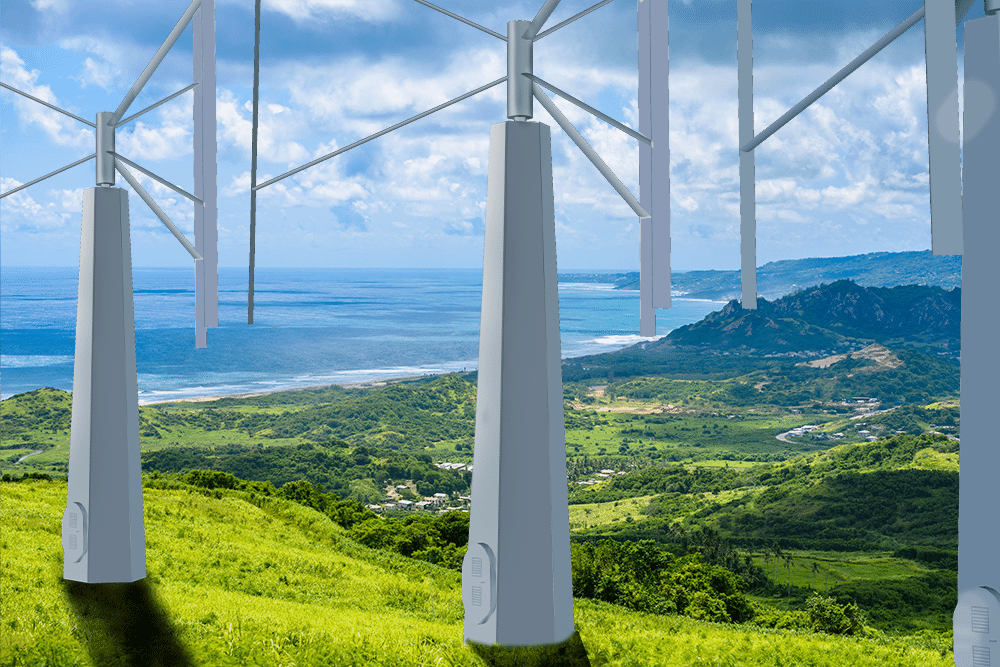Our compact Wind Harvesters can go where traditional turbines cannot. We are opening markets where the impact on views, aviation, or wildlife, the lack of large roads, or the presence of limiting setback easements prevent the permitting and installation of large, traditional turbine projects.
Low Impact on Views
Wind Harvesters are an excellent option for producing renewable energy where restrictions protect scenic views and prevent traditional turbines from being placed. Traditional wind turbine blades generally extend from 300 to 500 feet in the air and can be seen for many miles. As a result, numerous local and national governments have enacted policies that restrict tall turbine installations despite high wind speed resource availability.
Wind Harvesters are significantly shorter than traditional turbines, standing only 60-80 ft tall. In addition, we are dedicated to reducing our visual impact by using sophisticated visual studies to place our turbines along ridgelines, among hills, and farther back in the landscape to significantly lessen or even eliminate their visual impacts.
Restricted Areas due to Aviation
Turbines with 150-foot-long blades impact radar systems and their ability to evaluate aviation and weather conditions. Air-traffic regulations often prohibit these turbines from being installed near airports or areas where they could decrease radar effectiveness, impact aviation, military safety, or weather forecasts. The taller and larger their rotors are, the more problematic traditional turbines can become.
Wind Harvesters are designed for mid-level wind and rotate around a vertical axis. Studies predict they won’t cause radar interference. Moreover, their short height allows them to become nearly indistinguishable from other similarly sized trees and objects.
Locations near airports have specific height restrictions that limit wind energy production. For example, in windy southern Solano County, CA, there is a height restriction against installing new turbines taller than 100 feet above the ground to protect flights coming into and out of Travis Air Force Base.

Smaller Properties
The rules for placement of wind turbines on a property vary around the world; however, generally, local ordinances require that a wind turbine be at least 1.1 times the height of the turbine away from the property line. A 300-foot-tall traditional wind turbine must be at least 330 feet away from all sides of the property preventing owners of smaller, windy properties from placing existing wind turbines on their land. In this same scenario, a Wind Harvester would only need to be 88 feet from the property line. This spacing would allow many distribution warehouses, data centers, and other energy intensive industries to take advantage of good local wind resources, produce clean energy and lower their electrical bills.
Locations with Tight and Twisting Roads
Wind Harvesters can be transported on standard flatbed trucks or in forty-foot land-sea containers. Our turbines are installed with easily-available truck cranes and bucket lifts. All of these vehicles can navigate tight and twisting roads much more easily than vehicles hauling traditional turbines. The simplicity and size of the Wind Harvester design open up opportunities for installation on mountains and ridgelines where radio and telecom towers exist, and mid-level wind accelerates.
Windy Islands
With plentiful, near-constant, but often lower speed “trade” winds and 100% renewable energy goals, islands like Barbados and Hawaii need compact but industrial-scale turbines.
These factors, and more, make our Wind Harvesters a great solution for windy islands, peninsulas, coastal areas, mountain tops, ridgelines, and more.
The northernmost land on the island of Barbados has mid-level average annual wind speeds reaching 16 mph. Dr. Ariana Marshall is helping prepare the bird and wildlife studies and develop the pilot projects and cumulative environmental and cultural impact analyses needed for large-scale installations of Wind Harvesters here and on other islands in the Caribbean.



